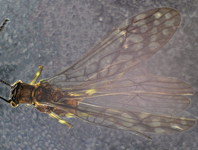Abstract
Two new species of Hemiosus (Coleoptera: Hydrophilidae) from the central cordillera of the Colombian Andes are described. Hemiosus molanoi González-Rodríguez & García-Hernández sp. nov. and H. quindiensis González-Rodríguez & Clarkson sp. nov. are described based in 56 adult specimens collected in river-associated sandy puddles (26 specimens of H. molanoi sp. nov.) and temporary puddles near crops (26 specimens of H. quindiensis sp. nov.). Both species are identified mainly by characteristics of the aedeagus: Hemiosus molanoi sp. nov. has subtriangular parameres, median lobe shorter than parameres and longer than appendices which are acuminate and phallobase shorter than parameres, strongly asymmetrical in basal two-fifths; H. quindiensis sp. nov. has parameres gradually tapering towards rounded apices, median lobe shorter than parameres and longer than appendices which are acuminate and phallobase shorter than parameres, strongly asymmetrical in basal half. Dorsal coloration pattern, overall shape of the meso- and metaventral process and abdominal ventrites are also informative to distinguish the new species from remaining described Hemiosus. Diagnoses, illustrations and habitat characteristics are provided.
References
Clarkson, B. & Ferreira-Jr, N. (2009) Three new species of Hemiosus Sharp (Coleoptera: Hydrophilidae) and new state records of Hemiosus fittkaui Oliva and H. moreirai d’Orchymont from Brazil. Zootaxa, 2139, 61–68.
Hadley, A. (2010) CombineZP. Available from: http://www.hadleyweb.pwp.blueyonder.co.uk (accessed 2018)
Hansen, M. (1991) The Hydrophiloid Beetles. Phylogeny, classification, and a revision of the genera (Coleoptera). Biologiske Skrifter, 40, 1–367.
Hansen, M. (1999) World Catalogue of Insects 2: Hydrophiloidea (s. str.) (Coleoptera). Apollo-Books, Stenstrup, 416 pp.
Oliva, A. (1987) El género Hemiosus en los Andes meridionales y la Patagonia (Coleopt., Hydrophilidae). Revista de la Sociedad de Entomología Argentina, 44 (3–4), 377–381.
Oliva, A. (1989a) Presencia en el sur de Bolivia de dos especies de Hemiosus (Coleoptera: Hydrophilidae) descritas del Peru Amazonico. Revista de la Sociedad de Entomología Argentina, 45 (1–4), 130, 152.
Oliva, A. (1989b) El género Berosus (Coleoptera, Hydrophilidae) en América del Sur. Revista del Museo Argentino de Ciencias Naturales., Entomología. 6 (4), 57–235.
Oliva, A. (1991) The types of Hemiosus Sharp, 1882 (Coleoptera: Hydrophilidae) in the Orchymont and Mouchamps collections. Bulletin de l´institut Royal des Science Naturelles de Belgique. Entomologie, 61, 167–181.
Oliva, A. (1994a) A revision of the genus Hemiosus Sharp, 1882 in South America (Coleoptera: Hydrophilidae). Bulletin et Annales de la Société royale belge d'Entomologie, 130, 267–330.
Oliva, A. (1994b) Una nueva especie de Hemiosus Sharp (Coleoptera:Hydrophilidae) de Venezuela. Revista de la Sociedad de Entomología Argentina. 53 (1–4), 75–77.
Oliva, A. & Short, A.E.Z. (2010) A remarkable new species of Hemiosus from Amazonian Peru (Coleoptera: Hydrophilidae). Koleopterologische Rundschau, 80, 139–142.
Orchymont, A.d'. (1940) Contribution al'etude des Palpicornia XIV. Bulletin et Annales de la Societé Entomologique de Belgique, 80, 157–197.
Gonzalez-Rodriguez, L.M., García-Hernández, A.L. & Clarkson, B. (2017) First records of water scavenger beetle species (Coleoptera, Hydrophilidae) from Quindío Department, Colombia. Check List, 13 (5), 605–620.
https://doi.org/10.15560/13.5.605
Short, A.E.Z. & Torres, P.J. (2006) Review of the Hemiosus Sharp and Derallus Sharp of North America, Central America, and the Caribbean (Coleoptera: Hydrophilidae: Berosini. Zootaxa, 1369, 1–17.
Short, A.E.Z. & Fikáček, M. (2011) World catalogue of the Hydrophiloidea (Coleoptera): additions and corrections II (2006–2010). Acta Entomologica Musei Nationalis Pragae, 51 (1), 83–122.
Spangler, P.J. (1966) The Catherwood Foundation Peruvian-Amazon Expedition. XIII. Aquatic Coleoptera (Dytiscidae; Noteridae; Gyrinidae; Hydrophilidae; Dascillidae; Helodidae; Psephenidae; Elmidae). Monographs of the Academy of Natural Sciences of Philadelphia, 14, 377–443.

